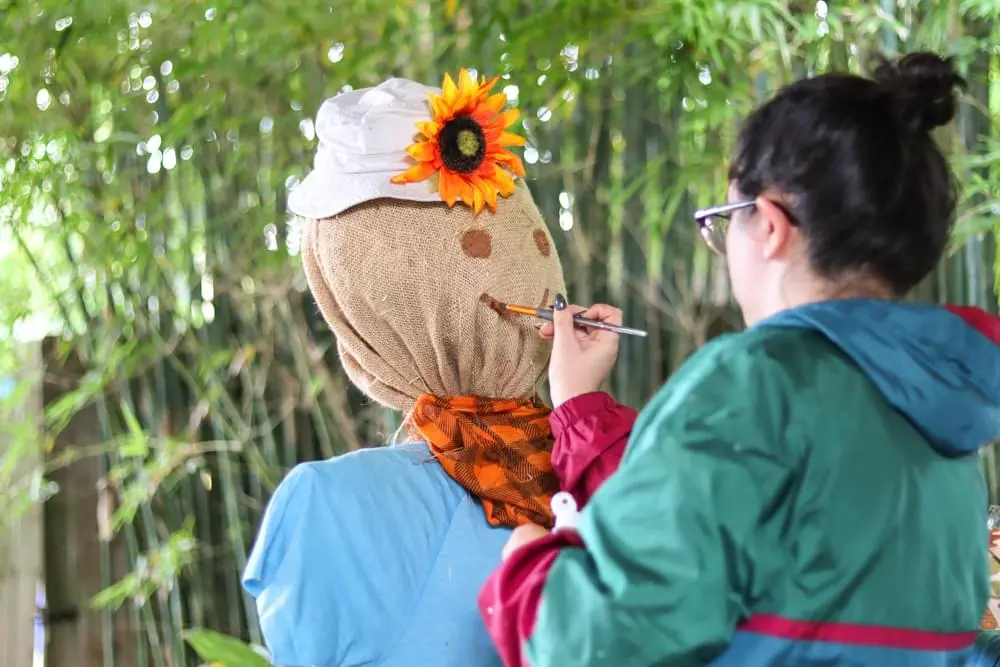by Amanda Rose Newton

Ubiquitous to Halloween, the fall, and the rural countryside, scarecrows have been associated with the pre-Thanksgiving harvest for about as long as we have been present on Earth. For having such longevity, the actual history of how and why the scarecrow came to be is a bit of an autumn mystery– which is why we time our annual scavenger hunt during the spookiest month of the year!
Below, we’ll explore a few of the many past lives of the scarecrow as well as what may be in store for them in their next chapter.
Scarecrows: From Africa to Greece
The first documented scarecrows (that we know of) were used by ancient Egyptians to scare pesky quail into bird nets. Not resembling modern scarecrows at all, often they were more like poles with bird netting over them. In fact, they served a dual purpose to not only confuse the quail but also to hopefully entrap them to provide that evening’s dinner.
The Greeks loved to incorporate their collection of gods and goddesses into all aspects of life, including agriculture. The first scarecrows were not meant to be scary at all, but to symbolize the gods of viticulture (wine production), horticulture, and agriculture.
Around 2,500 B.C. is where we see this notion take a sinister turn, with scarecrows decorated in the likeness of Priapus (son of Aphrodite) who was said to be heinous enough to scare birds and any other mooches out of the vineyards. Scarecrows picked up props during this time as well, often holding a sickle or a club to look extra menacing.
East Asian Influence
Around the same time the Greeks were outfitting their scarecrows with clubs and ugly expressions, the Japanese began a similar practice to protect their vast rice fields. Their scarecrows are known as Kakashis and were the first to truly resemble humans. They took care to dress them, often in raincoats and straw hats, to make them look more life-like. Many outfitted them with bows and arrows to make onlookers think twice about entering the fields.
Scarecrows showed up in literature from the period as well, usually as understanding much about the world despite the fact they are forever stuck in one place.

Medieval Times
The life of the scarecrow took a spooky turn during medieval times and were dressed to look like witches. Farmers were hopeful the magic they possessed would help the spring come quickly and equate to a successful harvest.
The black plague brought famine to much of Europe, and witch scarecrows were meant to scare hungry souls away from pillaging crops.
In Germany, family children often were given jobs as “live scarecrows” and would spend their days throwing stones at crows and other birds threatening crops. Many wore face paint, hats, or stuffed their clothing with straw to seem more menacing. It is believed our practice of stuffing scarecrows and applying faces to them came from this time period.
American Made Scarecrows
Immigrant German farmers are likely the ones who brought scarecrows to American soil. There is also anecdotal evidence that the German word for scarecrow, “bootzaman” is what gave rise to the Halloween Horror genre favorite, the Boogeyman.
Native Americans had their own version going on way before Germans arrived, using live adults as professional bird scarers and building their own. The Southwestern Zuni held contests for constructing the best scarecrow, and here at Rockledge Gardens, we are keeping this tradition alive with our scavenger hunt this October.
Scarecrows are still used today with some getting a technological facelift. Many feature enhancements such as shiny ribbons that spin to confuse birds, or the ability to produce obnoxious noises to startle rodents, bears, and curious neighbors.
This fall, start a new tradition of taking seasonal advice from perhaps the most knowledgeable member of the garden.
Given how long scarecrows have persisted in the field, they have likely seen it all.


